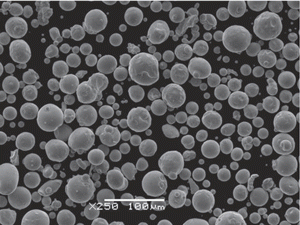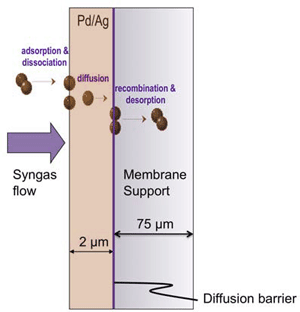Improved atomisation technology produces ultrafine powders for fossil fuel power plants
In this exclusive report for ipmd.net, Bernard Williams reviews the developments so far.
NETL states that the new ferritic stainless steel powders developed in the ongoing research project offer high thermal conductivity, high creep resistance, and low thermal expansion (low void swelling during neutron irradiation) allowing them to withstand the demanding high temperature, high pressure, and often corrosive environments required in FE power plants.
The new gas atomised oxide dispersion strengthened (ODS) powders based on Fe-Cr are also considered to be a lower cost alternative to currently used mechanically alloyed ODS alloys for high temperature FE applications, allowing the FE plants to operate more efficiently with reduced emissions and adaptability to carbon sequestration or capture.
One of the focuses of the work at NETL and Ames was to provide the level of atomised powder size control needed for the discrete jet close-coupled atomisation process. The nozzle and control system developed for gas atomisation involved two procedures, the first of which was to achieve an increase in the efficiency of the melt disintegration process using a high pressure gas atomisation (HPGA) system to produce high yields of ultrafine powder. This was done by adjusting the gas jet arrays to affect the supersonic gas flow pattern, and by choosing the optimum atomisation gas.
The developed HPGA technology allowed researchers to control the droplet size to maximise ultrafine powder yield and increase intermediate powder yield. Particle sizes include ultrafine powders, with particle diameters of less than 10 microns (μm), and mid-range powders, with particle diameters ranging between 10 and 44 μm. This was accomplished by using gas flows of reduced energy with atomisation nozzles of different array diameters and advanced orifice designs.
The HPGA system was used to produce ultrafine powders which are said to have helped eliminate a major barrier to the use of new concepts for fabrication of hydrogen membranes for advanced coal fired power plants with CO2 capture capability. A smooth micro-porous metallic support surface was developed with Los Alamos National Laboratory (LANL), for example for fabrication of robust hydrogen separation membranes from Pd alloy thin films approximately 2 µm thick.
Recent work involved sintering of a 75 µm thick primary membrane support layer from ultrafine (<3 µm dia.) gas-atomised spherical Fe-16Al-2Cr (wt.%) powder onto a coarse (40 µm porosity) stainless steel frit as a secondary support. Crack-free membrane support surfaces with 0.1-0.5 µm porosity resulted and a finished membrane was reported to have achieved encouraging hydrogen separation performance.
NETL reported that previous collaboration with LANL on partially sintered ultra-fine iron aluminide powders as porous supports for hydrogen separation membranes had resulted in US Patent No. 7,611,565 B1, issued on November 3, 2009.
Gas atomisation approach to ODS alloys
A second focus of the research project involved ‘innovative gas atomisation reaction synthesis’ (GARS). Here the addition of reactive gas components generated on precursor powders was used to serve as an oxygen reservoir for subsequent formation of uniformly dispersed precipitates during HIPing and heat treatment.
According to a report by Iver E. Anderson and colleagues* (Ames Lab) the precursor powder for the ODS alloys was produced using GARS using a reactive gas mixture of Ar and O2. The reaction parameters (i.e., reactive gas content and inlet position) and the nominal chemical composition of each alloy are shown in Table 1.

Table 1 Nominal alloy composition (wt%) and atomisation processing parameters for producing precursor powders for the ODS alloys by GARS* (courtesy AMES Laboratory)
The GARS process coats each individual powder particle in situ with an ultrathin (<100 nm) metastable surface Cr-enriched oxide shell oxide shell during rapid solidification. The oxide shell is later used as an oxygen reservoir for the formation of nano-metric yttrium-enriched oxide (Y-(Ti,Hf)) dispersoids during hot isostatic pressing. Hot isostatic pressing (HIP) at 850°C or 1300°C and pressure of 303 MPa for 4 hrs, fully consolidated the ODS precursor powder.
The first US Patent on the general approach to production of dispersion-strengthened alloys from GARS powders was issued on April 20, 2010, with two additional patent applications under examination. A project was begun in December 2009 with a major industrial partner to commercialise this new simplified ODS alloy production technology.
Powder production tests have been performed in laboratory atomisation systems to produce prototype batches of ultrafine high-temperature alloy powder in sufficient quantity for subsequent powder processing trials; production of a batch of intermediate-sized alloy powder in sufficient quantities for thermal spray trials; and mechanical testing and microstructure analysis.
The technology demonstrated steady-state operation and controls systems suitable for industrial use, and is expected to extend the benefits of powder metallurgy within and beyond the fossil energy field. The ability to produce high yields of specific sizes of powder particles by gas atomisation is additionally expected to help lower the cost of specialty metal powders.
*’Advanced Processing of Metallic Powders for Fossil Energy Applications’ by I.E. Anderson, D.J. Byrd, J.R. Rieken at Ames Lab, Iowa University, and S.N. Paglieri at Los Alamos National Laboratory, Los Alamos, New Mexico.
News | Articles | Market reviews | Search directory | Subscribe to e-newsletter







